Rock-Breaking Properties Under the Rotatory Impact of Water Jets in Water Jet Drilling
Abstract
:1. Introduction
2. Materials and Methods
2.1. Experimental Equipment and Sample Preparation
- (1)
- A high-pressure water pump was used which was a five-pulse fracturing pump (Nanjing Liuhe Company, Nanjing, China) with a rated pressure of 56 MPa and a flow rate of 200 L/min.
- (2)
- The synthetic coal specimens used were of the same composition as those described by Gao (2016) [19]. They were molded from a mixture of cement, pulverized coal, gypsum, and water; the aggregate was 60–80 mesh coal powder, and the binder cement and gypsum. The proportions of the material were cement to gypsum to pulverized coal 32:32:17. The appropriate amount of water (water–cement ratio = 0.4) was added and the mixture was stirred until uniform and then poured into a 100 mm cubic mold for curing. This produced specimens like that shown in Figure 2. The average physical and mechanical properties of a fully cured specimen briquette were density 1498 kg/m3, compressive strength 2.45 MPa, Poisson ratio 0.19, elastic modulus 1.59 GPa, internal friction angle 26.8°, and cohesion 0.74 MPa. These properties met the experimental requirements.
- (3)
- A nozzle was used. The water jet bit was a high-speed jet generating mechanism that used a conical convergence nozzle with an aperture 1.2 mm in diameter. The nozzle was located 10 mm from the bit axis, as shown in Figure 3.
2.2. Experimental Methods
3. Results and Discussion
3.1. Effect of Jet Pressure on Rock Breaking
3.2. Effect of Rotation Speed on Rock Breaking by Jet Rotation Impact
3.3. Effect of Water Jet Impact Angle on Rock Breaking
- There is an optimal jet impact angle that maximizes crushed pit depth for both rotational and fixed erosion tests. In the range examined by our experiments, an impact angle of 10° resulted in the deepest pits. The main reason for this is that the water jet eroded the rock to form a slot and there was high-pressure water in the slot. This high-pressure water acts as a “water cushion,” and when the water jet impacts the rock at a specific angle, the water cushion can reduce the jet’s reflection angle. After a groove is formed by the water jet, the flow of water is facilitated and the cuttings are washed away. However, if the impact angle is increased too much, the impact force transmitted from the jet to the rock will be reduced, resulting in decreased erosion [24,25]. Our experiments run at different flow velocities, rotation rates, and impact angles resulted in no significant change in crushed pit diameter. The diameters of the crushed pits for the 12-100-30 specimens increased by only 0.4 mm, and the diameter of the crushed pits varied by ±5%. The change was not large and may have been caused by differences in specimen strength or may have only been an apparent change caused by measurement errors.
- Under fixed erosion, when the jet pressure was 6 MPa, the variations in rock-breaking depth for different impact angles were small; the maximum crushed pit depth was 14.60 mm. The rock-breaking depth under rotating jet erosion was much greater, and the maximum pit depth was 28.80 mm, which was essentially twice the depth of the fixed erosion pits. This shows that for low-pressure water jets, jet rotation speed is the dominant factor for breaking rock and the jet impact angle is of secondary importance.
- The volume of rock broken during the rotation and fixed erosion experiments showed completely different growth modes. Under our experimental conditions the rock-breaking volume increased exponentially as impact angle increased. Although the effective rock-breaking distance exceeded the effective rock-breaking distance of the jet as the impact angle of the jet increased, the depth to which the rock was broken became significantly shallower as the impact angle increased. However, as shown in Figure 10, an oblique jet impact exerted a tensile force on the surface of the rock. The rock was rapidly damaged in an area extending radially from the jet and the radius of the crushed pit increased dramatically. This resulted in an increase in the rock-breaking area of the jet so that the rock-breaking volume by jet rotary erosion presented an exponential growth mode.
3.4. Self-Rotating Bit Design Considerations
4. Conclusions
- The volume of crushed pit by rotary jet erosion increases as the jet pressure increases. The erosion from a rotating bit increases quadratically with pump pressure but the increase is consistent with the results from fixed jet erosion. The depth to which the rock is broken is the dominant factor that defines the volume of broken rock; the diameter or the area broken is of secondary importance.
- There is an optimum jet bit rotation speed for rock-breaking erosion, and this speed correlates positively with pump pressure. The reason there is an optimum speed is that it is difficult for pressurized water to collect at the bottom of the cutting groove when the jet rotates and erodes the rock, and this lack of water in the groove reduces the water cushioning effect and enhances the breaking ability of the water jet. However, excessive rotation speed causes the jet to deflect and atomize, and the effective erosion range becomes shorter, leading to the weakening of the jet’s rock-breaking ability.
- An optimum rock-breaking impact angle (10°) exists for the jet to break the rock. The reason for this is that the water cushion effect and reflection of the jet are reduced when the jet impacts at an oblique angle, but the angle must not be too large. If the jet impact angle is increased too much, the large impact angle causes the jet’s impact force to decrease, resulting in a weakening of the jet’s erosion ability. However, when the jet is rotated to erode the rock, the rock eroded in an area radially around the jet increases because of the tensile forces on the rock surface. This leads to an exponential increase in the volume of rock broken by the jet.
- Concerning self-rotating water jet drill bit design, it can be concluded that: (1) the higher the pump pressure is, the greater the rock-breaking ability of the self-rotating bit will be. However, in this case the water consumption is higher, and the bit should be designed to match the performance of the other equipment in the drilling system (like the high-pressure pump). (2) The self-rotating bit has an optimum rock-breaking rotation speed, and this speed is positively correlated with the jet pressure. Hence, when designing the bit, it is necessary to add a speed-limiting mechanism to the bit to prevent bit rotation speeds that are too high. (3) The optimum rock-breaking angle for the self-rotating bit is about 10°. When a large volume of broken rock is to be obtained, the nozzle angle can be increased appropriately.
Author Contributions
Funding
Acknowledgments
Conflicts of Interest
References
- Yuan, L.; Xu, J.H. Key technology of pillarless coal and gas simultaneous mining in low permeability seam group. Coal. Sci. Technol. 2013, 41, 5–11. [Google Scholar]
- Shen, B.H.; Lei, Y. Strategic considerations on unconventional energy development in China coal mining area. Coal Sci. Technol. 2013, 41, 16–20. [Google Scholar]
- Hou, X.W.; Zhu, Y.M.; Liu, Y.; Wang, Y. A fully coupled model for the simulation of gas flow in multiscale shale reservoirs combining multiple effects. Appl. Sci. 2018, 8, 1063. [Google Scholar] [CrossRef] [Green Version]
- Wanniarachchillage, W.; Ranjith, G.; Mandadige, P.; Tharaka, R.; Mingzhong, G.; Eswaran, P. Investigation of depth and injection pressure effects on breakdown pressure and fracture permeability of shale reservoirs: An experimental study. Appl. Sci. 2017, 7, 664. [Google Scholar] [CrossRef] [Green Version]
- Yue, G.W.; Li, M.M.; Wang, L. Optimal layout of blasting holes in structural anisotropic coal seam. PLoS ONE 2019, 14, e0218105. [Google Scholar] [CrossRef] [PubMed]
- Xiao, S.Q.; Ge, Z.L.; Lu, Y.Y. Investigation on coal fragmentation by high-velocity water jet in drilling: Size distributions and fractal characteristics. Appl. Sci. 2018, 8, 1988. [Google Scholar] [CrossRef] [Green Version]
- Lu, Y.Y.; Xiao, S.X.; Ge, Z.L. Experimental study on rock-breaking performance of water jets generated by self-rotatory bit and rock failure mechanism. Powder Technol. 2019, 346, 203–216. [Google Scholar] [CrossRef]
- Sharma, V.; Chattopadhyaya, S.; Hloch, S. Multi response optimization of process parameters based on Taguchi—Fuzzy model for coal cutting by water jet technology. Int. J. Adv. Manuf. Technol. 2011, 56, 1019–1025. [Google Scholar] [CrossRef]
- Zha, C.; Liu, G.; Li, J. Combined Percussive-Rotary Drilling to Increase Rate of Penetration and Life of Drill Bit in Drilling Hard Rock Formation. Chem. Technol. Fuels Oils 2017, 53, 254–262. [Google Scholar] [CrossRef]
- Song, J.; Li, G.S.; Niu, J.L. Experimental study on flow structure of a dual-jet. J. Hydrodyn. (Ser. A) 2006, 21, 90–94. [Google Scholar]
- Li, G.S.; Song, J.; Hu, Y.T. Experimental study on rock breaking parameters of dual-jet. J. Chin. Univ. Pet. 2006, 30, 68–71. [Google Scholar]
- Song, J.; Li, G.S.; Hu, Y.T. Numerical simulation of dual jet turbulent flow with combined coaxial swirling and round jet. Chin. J. Hydrodyn. 2004, 5, 671–675. [Google Scholar]
- Yoshida, H.; Nishi, K.; Jsobe, T. Concrete Cutting Using Rotary Water Jet. In Proceedings of the 5th U.S. Water Jet Conference, Toronto, ON, Canada, 29–31 August 1989. [Google Scholar]
- Li, G.S.; Shen, Z.H.; Peng, Y. A theoretical study of hydraulically rotating jet nozzle. Acta Petrol. Sin. 1995, 4, 148–153. [Google Scholar]
- Liu, Y.Z.; Yu, H.Y.; Lu, T.K. Research on self-propelled high pressure water jet ultra-short radius horizontal drilling technology. Saf. Sci. Technol. 2005, 3, 33–37. [Google Scholar]
- Yang, B.K.; Lu, Y.Y.; Yang, X.F.; Feng, M.T.; Zhang, S. Design and research of self-propelled nozzle worked in coal seam with water jet. Mach. Des. Res. 2011, 38, 6–11. [Google Scholar]
- Liu, Y.Z.; Lu, T.K.; Liu, X.L. Self-feeding horizontal drilling technology with super-short radius for coal-bed methane wells. Nat. Gas Ind. 2006, 26, 69. [Google Scholar]
- Wang, Z.Q. Numerical Simulation of Rotating Nozzle and Its Parameters Research. Ph.D. Thesis, University of Science & Technology Beijing, Beijing, China, March 2006. [Google Scholar]
- Gao, Y.B. Research on the Mechanism of Permeability Enhancement Based on Breaking Coal-rock by Dynamic Impact of Water Jet in Boreholes and Its Application on Gas Extraction. Ph.D. Thesis, China University of Mining and Technology, Xuzhou, China, June 2016. [Google Scholar]
- Jiang, W.Z. Research on Theory of Slotting and Enhancing Permeability by High Pressure Rotational Jetting in Low Permeability Coal Seam and Its Application. Ph.D. Thesis, China University of Mining and Technology, Xuzhou, China, December 2009. [Google Scholar]
- Liu, X.; Liu, S.; Ji, H. Numerical research on rock breaking performance of water jet based on SPH. Powder Technol. 2015, 286, 181–192. [Google Scholar] [CrossRef]
- Bu, Y.H.; Wang, R.H.; Shen, Z.H. Analysis of flow-line and calculation of whirling flow intensity of rotational jet. J. Chin. Univ. Pet. 1998, 22, 45–47. [Google Scholar]
- Wang, W. Coal Breakage impact by High Pressure Rotary Water Jet and induced Pressure Relief and Permeability Enhancement by Hydraulic Flushing Cavity: Mechanism and Application. Ph.D. Thesis, China University of Mining and Technology, Xuzhou, China, May 2016. [Google Scholar]
- Liao, H.L.; Li, G.S. Experiment on rock breakdown by super-high-pressure water jet in submerged environment. Nat. Gas Ind. 2006, 26, 61. [Google Scholar]
- Liao, H.L.; Li, G.S.; Niu, J.L. Influential factors and mechanism analysis of rock breaking by ultra-high pressure water jet under submerged condition. Chin. J. Rock Mech. Eng. 2008, 6, 1243–1250. [Google Scholar]
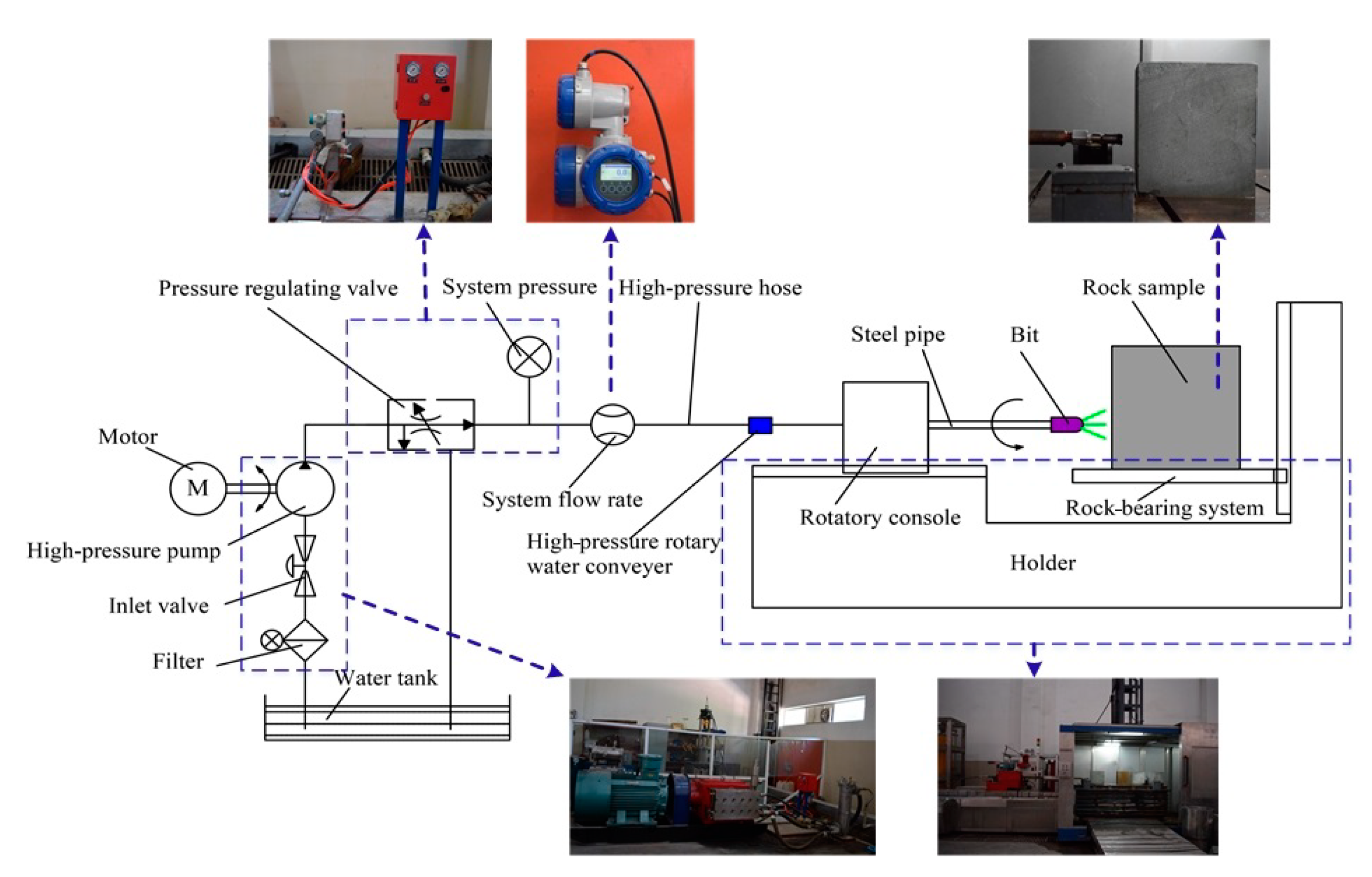
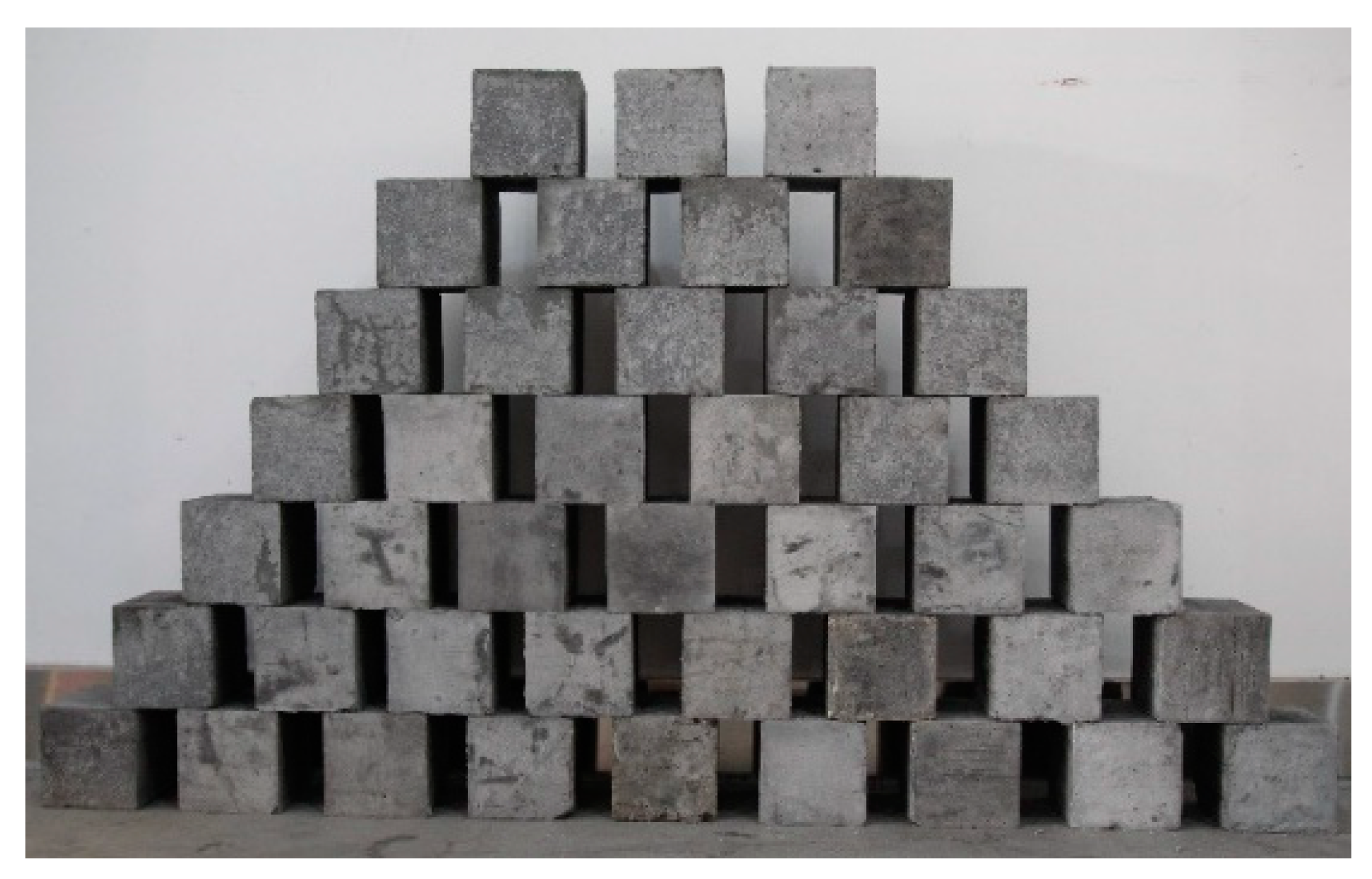

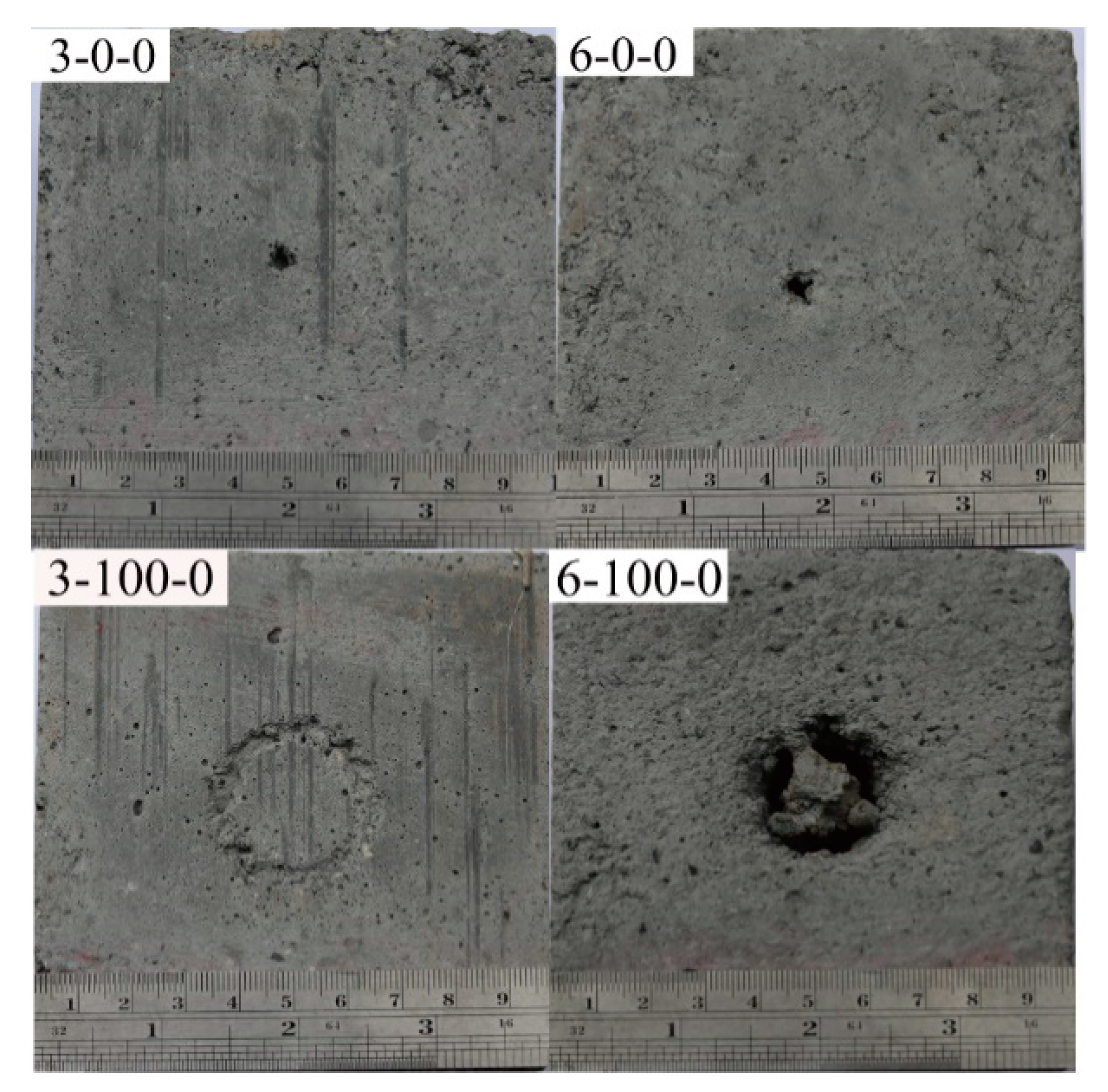
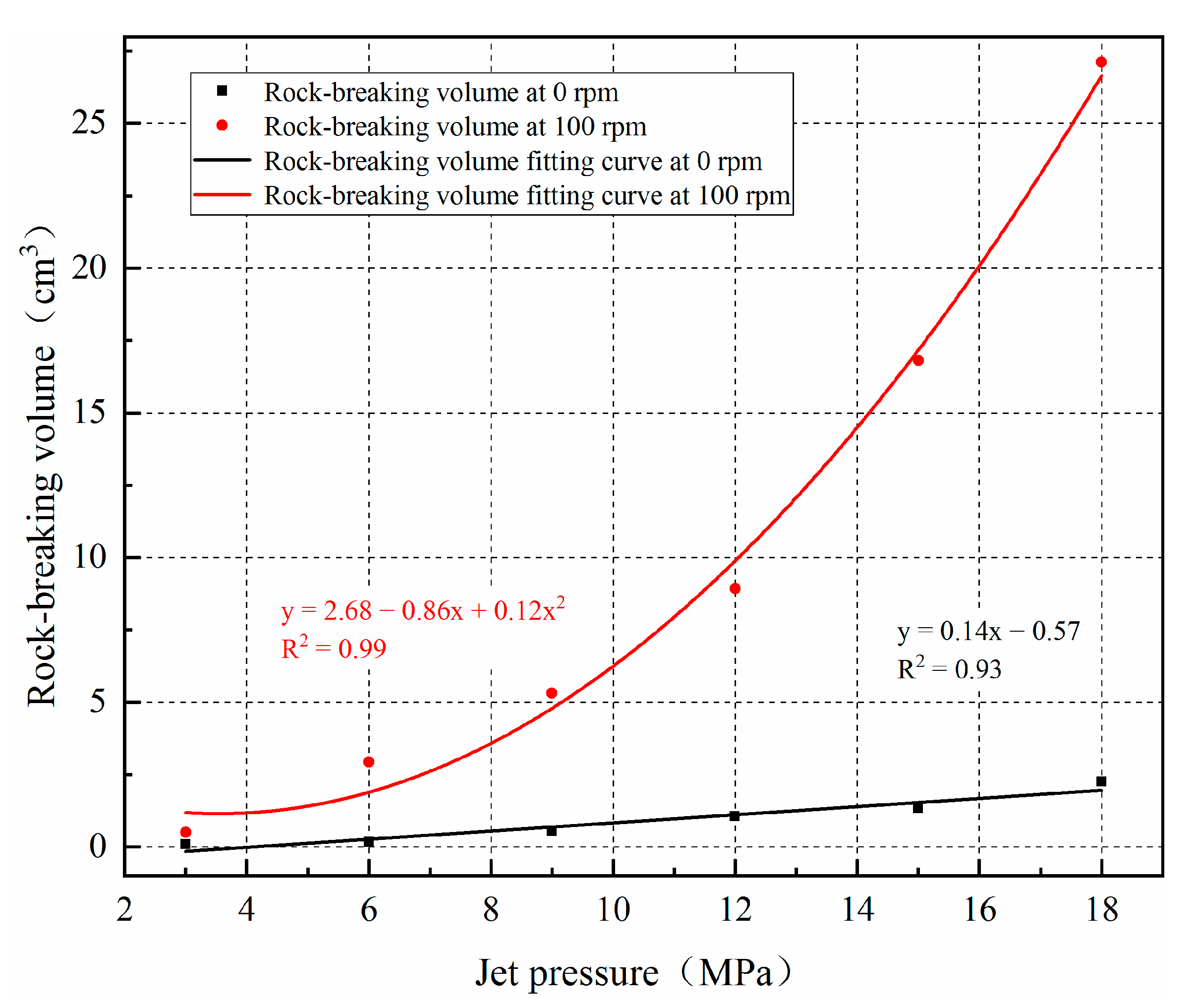
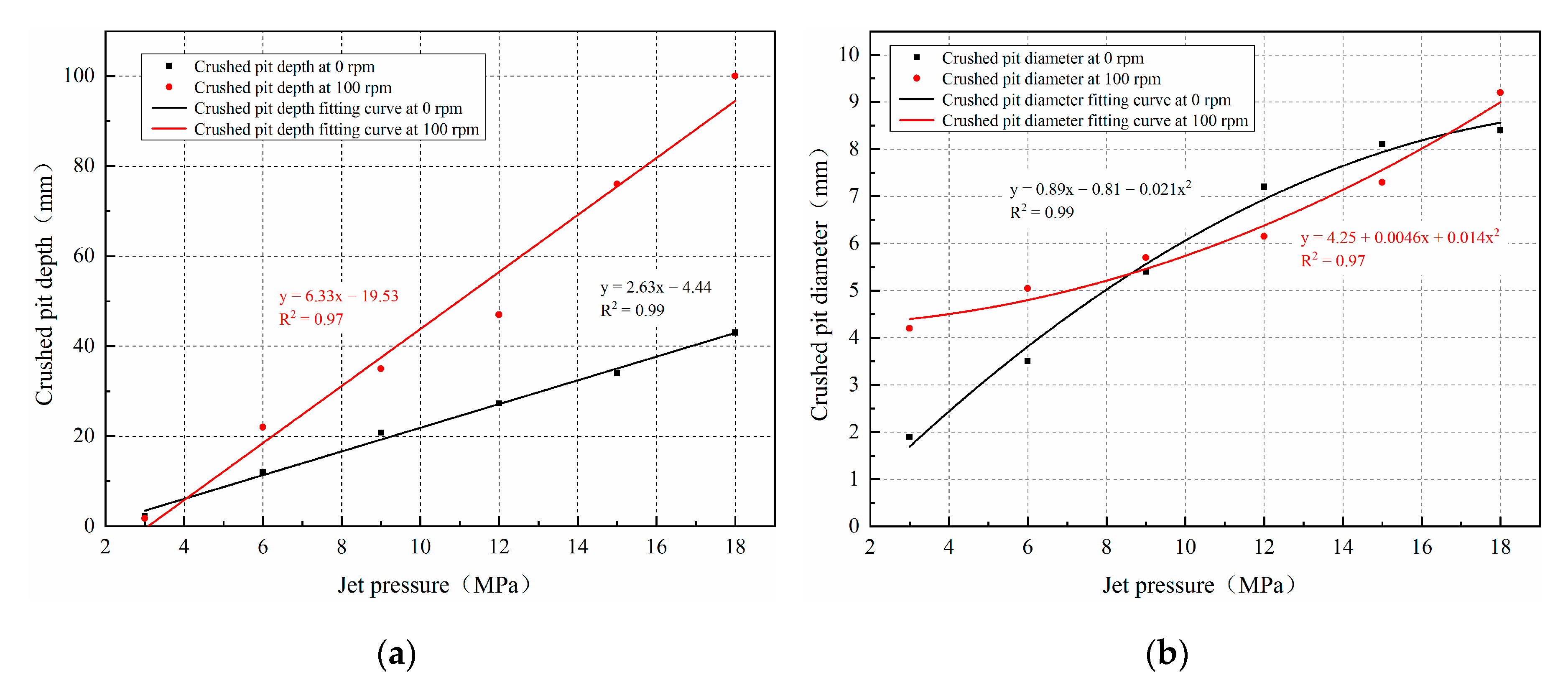
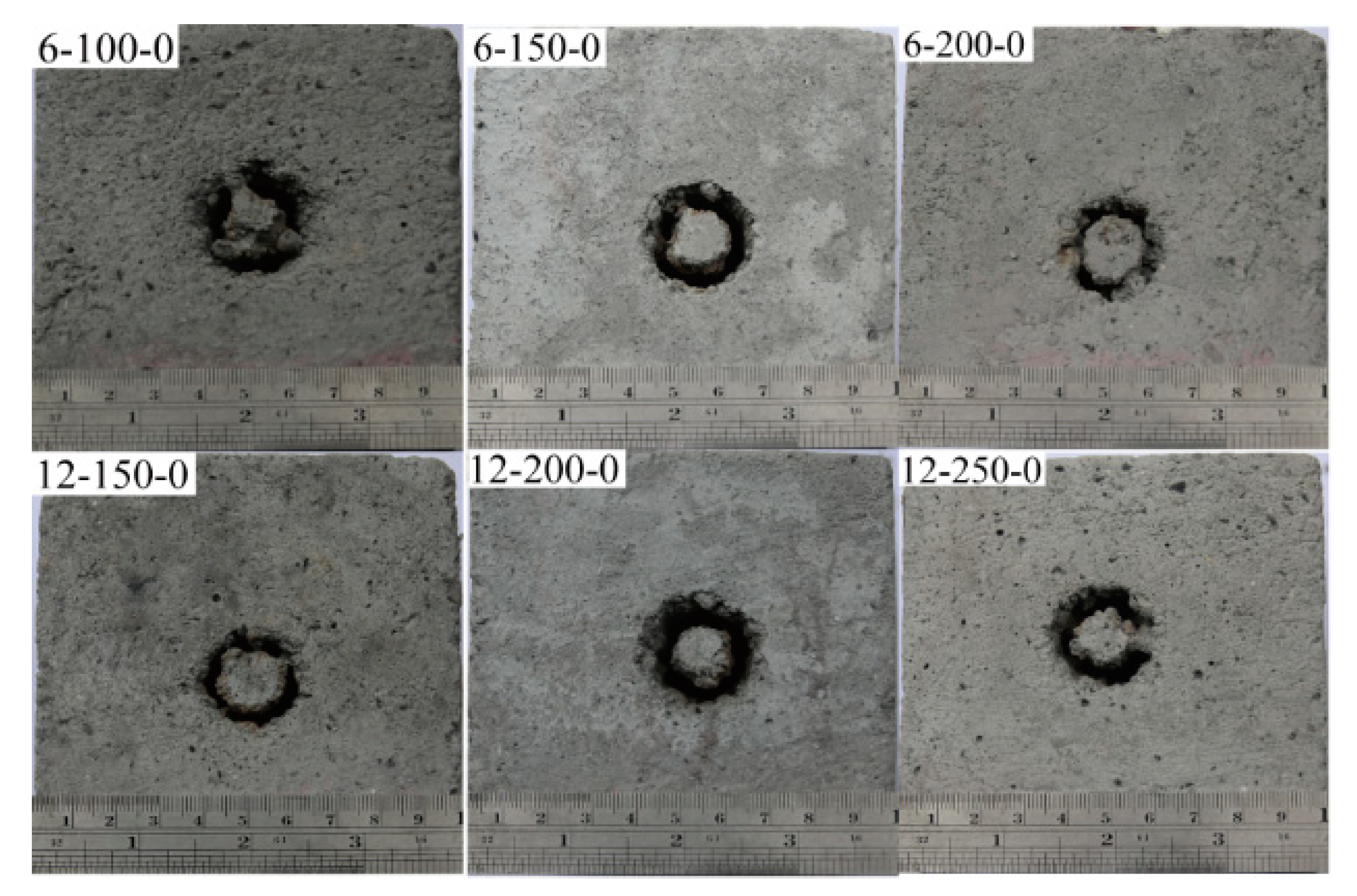
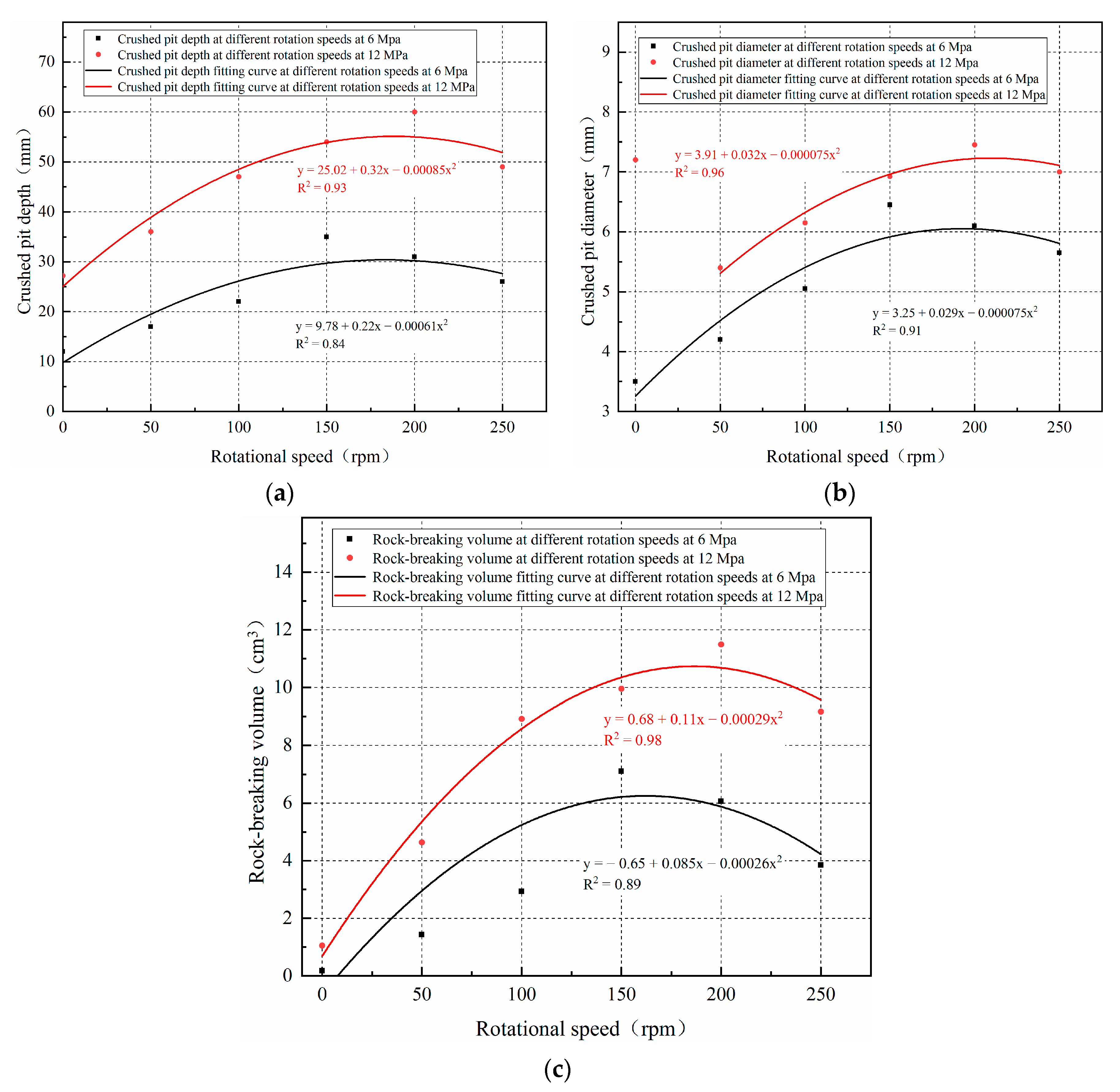

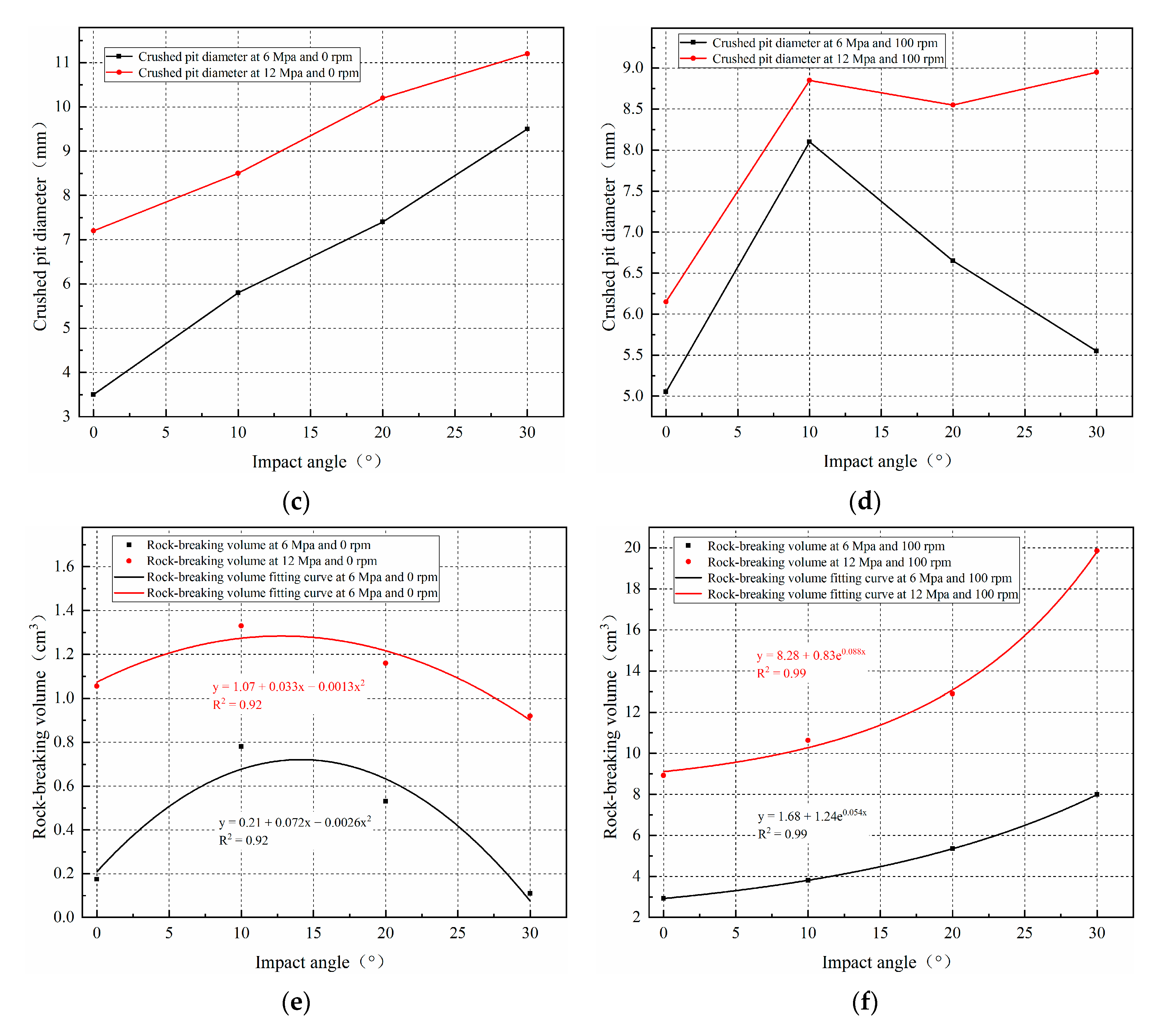

© 2019 by the authors. Licensee MDPI, Basel, Switzerland. This article is an open access article distributed under the terms and conditions of the Creative Commons Attribution (CC BY) license (http://creativecommons.org/licenses/by/4.0/).
Share and Cite
Ge, Z.; Wang, L.; Wang, M.; Zhou, Z.; Xiao, S.; Zhao, H. Rock-Breaking Properties Under the Rotatory Impact of Water Jets in Water Jet Drilling. Appl. Sci. 2019, 9, 5417. https://doi.org/10.3390/app9245417
Ge Z, Wang L, Wang M, Zhou Z, Xiao S, Zhao H. Rock-Breaking Properties Under the Rotatory Impact of Water Jets in Water Jet Drilling. Applied Sciences. 2019; 9(24):5417. https://doi.org/10.3390/app9245417
Chicago/Turabian StyleGe, Zhaolong, Lei Wang, Man Wang, Zhe Zhou, Songqiang Xiao, and Hanyun Zhao. 2019. "Rock-Breaking Properties Under the Rotatory Impact of Water Jets in Water Jet Drilling" Applied Sciences 9, no. 24: 5417. https://doi.org/10.3390/app9245417




